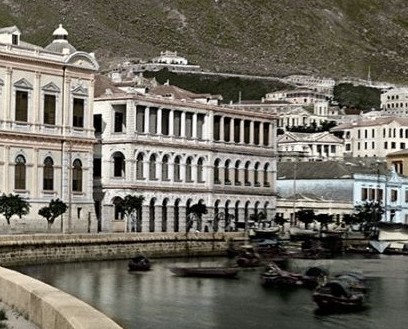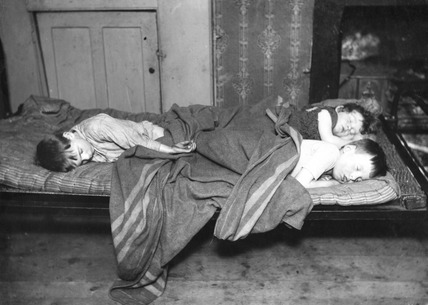|
Central Bank Of London
The Central Bank of London was a British commercial bank, based in London, England. The bank operated between 1863 and 1891 when it was acquired the Birmingham and Midland Bank. History Formation and Operations The bank was established in 1863 as the 'East London Bank', with its offices located in Cornhill in the City of London. Its early business was closely related to the East End trades, and so branches were soon opened at Southwark, Shoreditch and Whitechapel. Deposits had reached £495,000 by 1865, and by 1870 the bank was renamed the 'Central Bank of London'. In the mid 1870s further branches opened in Mile End, Blackfriars, Tottenham Court Road, Newgate Street and Clerkenwell. Deposits grew to £1 million in 1877 and further branches were opened at Shaftesbury Avenue and Bethnal Green during the 1880s. In 1889 the bank acquired the failing Bethnal Green Bank. Fate Still relatively small when compared to other competing London banks, the bank was acquired by th ... [...More Info...] [...Related Items...] OR: [Wikipedia] [Google] [Baidu] |
Commercial Bank
A commercial bank is a financial institution that accepts deposits from the public and gives loans for the purposes of consumption and investment to make a profit. It can also refer to a bank or a division of a larger bank that deals with wholesale banking to corporations or large or middle-sized businesses, to differentiate from retail banks and investment banks. Commercial banks include private sector banks and public sector banks. However, central banks function differently from commercial banks, despite a common misconception known as the "bank analogy". Unlike commercial banks, central banks are not primarily focused on generating profits and cannot become insolvent in the same way as commercial banks in a fiat currency system. History The name ''bank'' derives from the Italian word ''banco'' 'desk/bench', used during the Italian Renaissance era by Florentine bankers, who used to carry out their transactions on a desk covered by a green tablecloth. However, traces of ... [...More Info...] [...Related Items...] OR: [Wikipedia] [Google] [Baidu] |
Clerkenwell
Clerkenwell ( ) is an area of central London, England. Clerkenwell was an Civil Parish#Ancient parishes, ancient parish from the medieval period onwards, and now forms the south-western part of the London Borough of Islington. The St James's Church, Clerkenwell, church of St James in Clerkenwell Close and nearby Clerkenwell Green sit at the centre of Clerkenwell. Located on the edge of the City of London, it was the home of the Clerkenwell Priory, Priory of St John and the site of a number of wells and spas, including Sadlers Wells and Spa Green. The well after which the area was named was rediscovered in 1924. The Marquess of Northampton owned much of the land in Clerkenwell, reflected in placenames such as Northampton Square, Spencer Street and Compton Street. The watchmaking and watch repairing trades were once of great importance, particularly in the area around Northampton Square. In the 20th century, Clerkenwell became known as a centre for architecture and design. Cl ... [...More Info...] [...Related Items...] OR: [Wikipedia] [Google] [Baidu] |
Defunct Banks Of The United Kingdom
{{Disambiguation ...
Defunct may refer to: * ''Defunct'' (video game), 2014 * Zombie process or defunct process, in Unix-like operating systems See also * * :Former entities * End-of-life product * Obsolescence Obsolescence is the process of becoming antiquated, out of date, old-fashioned, no longer in general use, or no longer useful, or the condition of being in such a state. When used in a biological sense, it means imperfect or rudimentary when comp ... [...More Info...] [...Related Items...] OR: [Wikipedia] [Google] [Baidu] |
Banks Disestablished In 1891
A bank is a financial institution that accepts deposits from the public and creates a demand deposit while simultaneously making loans. Lending activities can be directly performed by the bank or indirectly through capital markets. As banks play an important role in financial stability and the economy of a country, most jurisdictions exercise a high degree of regulation over banks. Most countries have institutionalized a system known as fractional-reserve banking, under which banks hold liquid assets equal to only a portion of their current liabilities. In addition to other regulations intended to ensure liquidity, banks are generally subject to minimum capital requirements based on an international set of capital standards, the Basel Accords. Banking in its modern sense evolved in the fourteenth century in the prosperous cities of Renaissance Italy but, in many ways, functioned as a continuation of ideas and concepts of credit and lending that had their roots in the ancien ... [...More Info...] [...Related Items...] OR: [Wikipedia] [Google] [Baidu] |
1891 Disestablishments In England
Events January * January 1 ** A strike of 500 Hungarian steel workers occurs; 3,000 men are out of work as a consequence. **Germany takes formal possession of its new African territories. * January 4 – The Earl of Zetland issues a declaration regarding the famine in the western counties of Ireland. * January 5 **The Australian shearers' strike, that leads indirectly to the foundation of the Australian Labor Party, begins. **A fight between the United States and Lakotas breaks out near Pine Ridge agency. **A fight between railway strikers and police breaks out at Motherwell, Scotland. * January 7 ** General Miles' forces surround the Lakota in the Pine Ridge Reservation. ** The Inter-American Monetary Commission meets in Washington DC. * January 9 – The great shoe strike in Rochester, New York is called off. * January 10 – in France, the Irish Nationalist leaders hold a conference at Boulogne. The French government promptly takes loan. * Janua ... [...More Info...] [...Related Items...] OR: [Wikipedia] [Google] [Baidu] |
1863 Establishments In England
Events January * January 1 – Abraham Lincoln signs the Emancipation Proclamation during the third year of the American Civil War, making the abolition of slavery in the Confederate States of America an official war goal. The signing proclaimed the freedom of 3.1 million of the nation's four million slaves and immediately frees 50,000 of them, with the rest freed as the Union Army advances. This event marks the start of America's Reconstruction Era. * January 2 – Master Lucius Tar Paint Company (''Teerfarbenfabrik Meister Lucius''), predecessor of Hoechst, as a worldwide chemical manufacturing brand, founded in a suburb of Frankfurt am Main, Germany. * January 4 – Founding date of the New Apostolic Church, a Christian and chiliastic church, in a schism with the Catholic Apostolic Church in Hamburg, Germany. * January 7 – In the Swiss canton of Ticino, the village of Bedretto is partly destroyed and 29 killed by an avalanche. * January 8 ** ... [...More Info...] [...Related Items...] OR: [Wikipedia] [Google] [Baidu] |
HSBC
HSBC Holdings plc ( zh, t_hk=滙豐; initialism from its founding member The Hongkong and Shanghai Banking Corporation) is a British universal bank and financial services group headquartered in London, England, with historical and business links to East Asia and a multinational corporation, multinational footprint. It is the List of banks in Europe, largest Europe-based bank by total assets, ahead of BNP Paribas, with US$3.098 trillion as of September 2024. This also puts it as the List of largest banks, 7th largest bank in the world by total assets behind Bank of America, and the 3rd largest State ownership, non-state owned bank in the world. In 2021, HSBC had $10.8 trillion in assets under custodian bank, custody (AUC) and $4.9 trillion in assets under administration (AUA). HSBC traces its origin to a Hong (business), ''hong'' trading house in British Hong Kong. The bank was established in 1865 in Hong Kong and opened branches in Shanghai in the same year. It was ... [...More Info...] [...Related Items...] OR: [Wikipedia] [Google] [Baidu] |
Bethnal Green Bank
Bethnal were a British rock band formed in 1972. In 1978, they released two albums on Vertigo Records: ''Dangerous Times'', produced by Kenny Laguna; and ''Crash Landing''; produced by Jon Astley and Phil Chapman, with special thanks to Pete Townshend. They supported some punk bands (999, Eater, The Boys, Slaughter & the Dogs, Buzzcocks...) and Hawkwind on their 1977 UK tour and, after disbanding, three of the members formed part of the backing band for the 1981 album ''Hype'' by former Hawkwind frontman Robert Calvert Robert Newton Calvert (9 March 1945 – 14 August 1988) was a South African-United Kingdom, British writer, poet, and musician. He is principally known for his role as lyricist, performance poet and lead vocalist of the space rock band Hawkwind .... Key members were George Csapo (vocals, keyboards, violin), Pete Dowling (drums), Nick Michaels (guitar) and Everton Williams (bass). References External linksDiscography on Punkygibbon British rock music gro ... [...More Info...] [...Related Items...] OR: [Wikipedia] [Google] [Baidu] |
Bethnal Green
Bethnal Green is an area in London, England, and is located in the London Borough of Tower Hamlets. It is in east London and part of the East End of London, East End. The area emerged from the small settlement which developed around the common land, Green, much of which survives today as Bethnal Green Gardens, beside Cambridge Heath Road. By the 16th century the term applied to a wider rural area, the ''Hamlet of Bethnal Green'', which subsequently became a Parish, then a Metropolitan Borough of Bethnal Green, Metropolitan Borough before merging with neighbouring areas to become the north-western part of the new Tower Hamlets. Economic focus shifted from mainstream farming produce for the City of London – through highly perishable goods production (market gardening), weaving, dock and building work and light industry – to a high proportion of commuters to city businesses, public sector/care sector roles, construction, courier businesses and home-working digital and cre ... [...More Info...] [...Related Items...] OR: [Wikipedia] [Google] [Baidu] |
Shaftesbury Avenue
Shaftesbury Avenue is a major road in the West End of London, named after The 7th Earl of Shaftesbury. It runs north-easterly from Piccadilly Circus to New Oxford Street, crossing Charing Cross Road at Cambridge Circus. From Piccadilly Circus to Cambridge Circus, it is in the City of Westminster, and from Cambridge Circus to New Oxford Street, it is in the London Borough of Camden. Shaftesbury Avenue was built between 1877 and 1886 by the architect George Vulliamy and the engineer Sir Joseph Bazalgette, to provide a north–south traffic artery through the crowded districts of St. Giles and Soho. The avenue is generally considered the heart of London's West End theatre district, with the Lyric, Apollo Apollo is one of the Twelve Olympians, Olympian deities in Ancient Greek religion, ancient Greek and Ancient Roman religion, Roman religion and Greek mythology, Greek and Roman mythology. Apollo has been recognized as a god of archery, mu ..., Gielg ... [...More Info...] [...Related Items...] OR: [Wikipedia] [Google] [Baidu] |
Newgate Street, London
Newgate was one of the historic seven gates of the London Wall around the City of London and one of the six which date back to Roman times. Newgate lay on the west side of the wall and the road issuing from it headed over the River Fleet to Middlesex and western England. Beginning in the 12th century, parts of the gate buildings were used as a gaol, which later developed into Newgate Prison. Name It was once thought that Newgate was "New" since it was built after the Roman period, but archaeological evidence has shown that it was of Roman origin; it is therefore possible that the gate was named so when the Ludgate became less used, due to the building of the fourth St Paul's Cathedral in the early medieval period. It was previously known as Chamberlains Gate, there was a landholding referred to as the Chamberlain's Soke lying just outside Newgate, forming part of the ward of Farringdon Without. Structure and history Excavations in 1875, 1903 and 1909 revealed the Roman stru ... [...More Info...] [...Related Items...] OR: [Wikipedia] [Google] [Baidu] |





